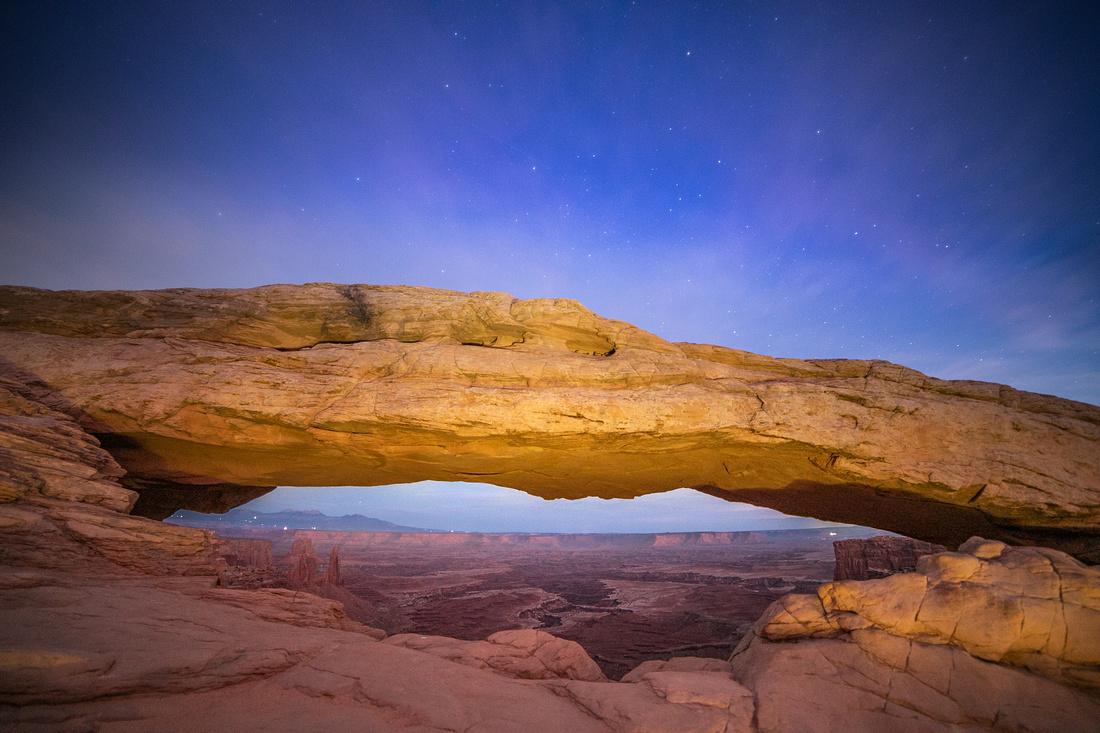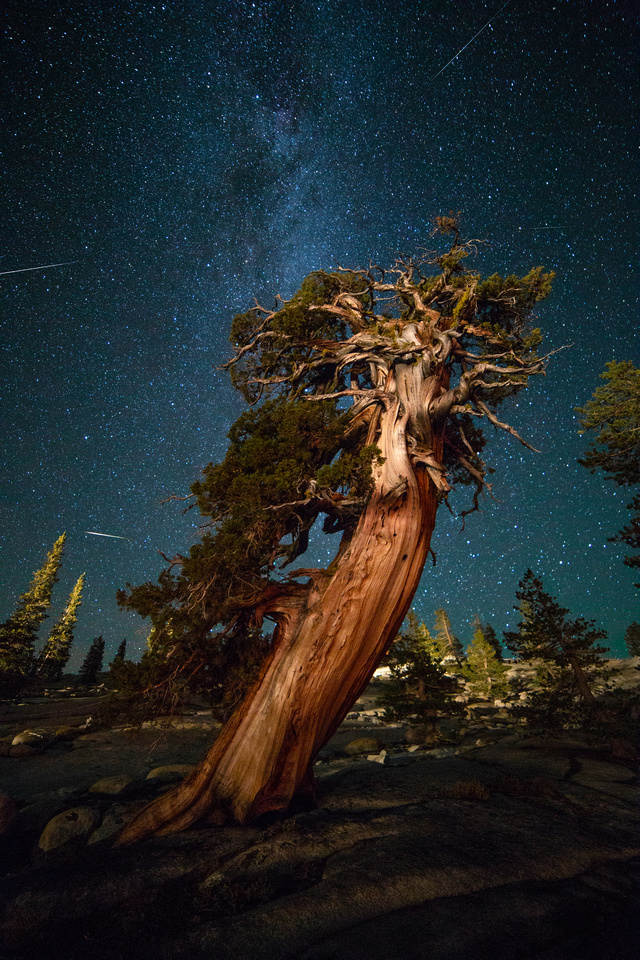The Night Life
The Night Life: How to capture subjects at night
Text and photos by Heather Cline
 
Mesa Arch, Canyonlands National Park |
Photographing at night can be intimidating but is a great way to expand your horizons and expertise. From full moon photography to star trails and the milky way, the night skies offer us many opportunities to practice the genre of astrophotography. This article will walk through some of my night shoots and the steps I took to get the resulting images.
Milky Way
This is a photo I took of a little bonsai type tree growing out of that classic red rock you see throughout the Southwest. This shot started way before I left my house though. I use an app called PhotoPills to plan night time shots. It is a great tool to predetermine where the Milky Way will be in relation to your subject.
 
Bonsai Tree Rock, Zion National Park |
I had been here and photographed this rock once before during the day. I remembered roughly where it was and used Photo Pills to determine where the Milky Way would be and at what time. This was shot in October so I knew I wasn't going to get the Milky Way's galactic center arced above the rock, but I could get it rising up behind it.
I was able to get to the shooting location in the afternoon so I scouted it out and used the PhotoPills app to see exactly where the Milky Way would be by using the "Night AR" feature. To do this, while in the app, you simply press the "Night AR" button and it will show you the stars, the direction they are traveling, and the Milky Way from where you are standing. The $10 cost of the app (for IOS) is worth it for this feature alone.
I came back to the location at night, and set up. I used a full frame Canon DSLR with a 14mm Rokinon lens that is highly rated for nighttime photography. I was shooting with a tripod since I would be taking long exposures. I brought along two battery operated spot lights to illuminate the rock and tree.
I knew I would be taking two exposures, one for the foreground and one for the sky. The reason I did this was because I was shooting with a wide aperture of f2.8 which resulted in a shallow depth of field. So, if the stars were in focus, the foreground would not be in focus. For this shot, I decided to start with the foreground.
I lit up the foreground then focused on the rock face. My settings were ISO = 800 ISO, Aperture = f8, shutter speed = 30 seconds. I never shined the spot lights directly on the rock. Instead, I used the rocks behind me and my light colored clothing to reflect the light back on the rock. This makes the light softer and more even.
After I finished the foreground shots, I moved on to the sky. I re-adjusted my settings to ISO = 3200 ISO, Aperture = f2.8, shutter speed = 30 seconds. To manually focus on the stars, I turned on the Live View function in my camera. I used that to zoom in to 10x and looked for a good fat juicy star to fine tune the focus. Once I had that locked in, I took a photo and checked the exposure and sharpness of the stars. This process was basically a "lather-rinse-repeat" until I was confident I got everything correct.
Once I was back home, I merged the two images using PhotoShop and applied the usual adjustments.
Star Trails
This is star trails over the "Pirate Ship" rock feature at Mono Lake. I actually hadn't planned to shoot this on this trip. I was taking a night photography workshop in the Ancient Bristlecones and a few of the participants decided to go to Mono Lake on the way home so I stayed to shoot with them. It was a fun night, trading stories, techniques, and photo locations with fellow photographers.
 
The Pirate Ship, Mono Lake |
For this shot, I used the PhotoPills app to determine where the North Star would be in relation to the pirate ship feature.
From there, I basically followed the same steps and settings as I used for the Milky Way shot above.
The one difference was lighting. Mono Lake is a popular location and there was at least a dozen photographers in this area shooting so we had to time our shots when people were lighting (or not lighting) up the pirate ship. It worked out though because the people lighting it up were to our left so it got some nice side light. The foreground was illuminated by myself and a couple other photographers coordinating with each other.
Light Painting
I love light painting and creating my own DIY lighting tools. There are so many cool tools you can buy but honestly, you can create plenty of lighting tools for a fraction of the price.
This was my attempt to light up the inside of the "Ghost Rider" sculpture at the Goldwell Open Air Museum near Beatty, Nevada.
 
Ghost Rider, Goldwell Open Air Museum |
I was here to photograph the Geminids Meteor shower over one of the abandoned buildings in the nearby Rhyolite Ghost Town, so I thought I'd do some sunset and night shots out at the museum.
Photographing this sculpture in this way was was a bit a whim. I was waiting around for another photographer to finish taking photos of his wife in front of another sculpture and started playing with my spotlights at this spot. I was able to balance one of my lights inside the sculpture, just out of view from the camera. It was only about 30 minutes after sunset at this point so there are stars in the sky just yet.
This was shot at 16mm, with the following settings: ISO = 160, Aperture = f11, and shutter speed = 30 seconds.
Moon Rise
This is the moon rising near Mono Lake. I actually came here to photograph the Perseids meteor shower in August 2020. I knew I was going to have a super short window of shooting time because the moon, at 59% was going to rise at 11:47 PM. There were more clouds this night than I was hoping for so the meteor shots were a bit of a bust, but I did get some nice clouds and stars so I couldn't complain.
 
Moon Rise, Mono Lake |
As I was walking back to my vehicle, I noticed the moon rising and stopped to grab a few pictures. My 14mm night lens was a bit too wide, so I switched over to my 16-35 mm and ultimately shot this at 18 mm. I love this shot because it looks like sunrise but with stars, which makes it unique.
The hardest part about this shot was lighting up the bushes in the foreground. I didn't want it to be dark nothingness, but these bushes reflect a ton of light and were overpowering the rest of the composition. I had to do a lot of trial and error by shining the light on bushes behind and on the sides of me to get it right.
This was shot with the following settings: ISO = 2000, Aperture = f4, and shutter speed = 30 seconds.
Meteor Shower
This is a shot with some faint tail ends of the Milky Way and a few meteors streaking through the sky.
 
Perseids Meteors, Yosemite National Park |
I actually took this photo a couple nights after the moon rise shot. The moon was down to 37% and wasn't rising until 12:17 AM so I had a slightly longer window of shooting time but would still miss the peak of the meteors that would occur hours later. It is because of this that I only captured 4 visible meteors this night. Some years are super awesome for Perseids and others are more challenging. Just being out here was pretty great though.
I followed the same methodology to capture this images as with the Milky Way, but once I set my camera to capture the stars (and meteors), I set my intervalometer to take recurring 30 second exposures for 90 minutes. Then I waited. . .
The foreground was illuminated using my trusty spotlights reflected off the granite behind me. Granite is awesome for reflecting light evenly. The light in the background was from car light sin the distance.
This was shot at 14mm with the following settings: ISO = 3200, Aperture = f2.8, and shutter speed = 30 seconds. The foreground was shot at 800 ISO and f8.
I hope this was helpful and inspires you to get out and enjoy this unique night life! If you have any questions, please drop me a comment. You can view some of my other night shots via the Night Life Gallery or my website gallery: After Dark.